Each database constructed for real-time analytics has a elementary limitation. While you deconstruct the core database structure, deep within the center of it you’re going to discover a unmarried element this is appearing two distinct competing purposes: real-time information ingestion and question serving. Those two portions operating at the similar compute unit is what makes the database real-time: queries can mirror the impact of the brand new information that used to be simply ingested. However, those two purposes immediately compete for the to be had compute assets, making a elementary limitation that makes it tricky to construct environment friendly, dependable real-time programs at scale. When information ingestion has a flash flood second, your queries will decelerate or day out making your utility flaky. You probably have a surprising surprising burst of queries, your information will lag making your utility no longer so genuine time anymore.
This adjustments as of late. We unveil true compute-compute separation that gets rid of this elementary limitation, and makes it conceivable to construct environment friendly, dependable real-time programs at large scale.
Sign up for the tech communicate on Compute-Compute Separation: A New Cloud Structure for Actual-Time Analytics on March 15, 2023 at 9am PST/ 12pm EST. I’m going to be explaining the brand new structure and the way it delivers efficiencies within the cloud with primary engineer Nathan Bronson.
The Problem of Compute Competition
On the center of each and every real-time utility you’ve gotten this trend that the information by no means stops coming in and calls for steady processing, and the queries by no means prevent â whether or not they come from anomaly detectors that run 24×7 or end-user-facing analytics.
Unpredictable Information Streams
Any individual who has controlled real-time information streams at scale will let you know that information flash floods are somewhat commonplace. Even essentially the most behaved and predictable real-time streams may have occasional bursts the place the amount of the information is going up in no time. If left unchecked the information ingestion will utterly monopolize all of your real-time database and lead to question sluggish downs and timeouts. Consider consuming behavioral information on an e-commerce web site that simply introduced a large marketing campaign, or the weight spikes a fee community will see on Cyber Monday.
Unpredictable Question Workloads
In a similar fashion, whilst you construct and scale programs, unpredictable bursts from the question workload are par for the path. On some events they’re predictable according to time of day and seasonal upswings, however there are much more eventualities when those bursts can’t be predicted as it should be forward of time. When question bursts get started eating the entire compute within the database, then they’re going to remove compute to be had for the real-time information ingestion, leading to information lags. When information lags cross unchecked then the real-time utility can not meet its necessities. Consider a fraud anomaly detector triggering an in depth set of investigative queries to grasp the incident higher and take remedial motion. If such question workloads create further information lags then it’ll actively reason extra hurt by means of expanding your blind spot on the precise improper time, the time when fraud is being perpetrated.
How Different Databases Maintain Compute Competition
Information warehouses and OLTP databases have by no means been designed to maintain excessive quantity streaming information ingestion whilst concurrently processing low latency, excessive concurrency queries. Cloud information warehouses with compute-storage separation do be offering batch information so much operating similtaneously with question processing, however they supply this capacity by means of giving up on genuine time. The concurrent queries won’t see the impact of the information so much till the information load is entire, developing 10s of mins of knowledge lags. So they aren’t appropriate for real-time analytics. OLTP databases arenât constructed to ingest large volumes of knowledge streams and carry out move processing on incoming datasets. Thus OLTP databases don’t seem to be fitted to real-time analytics both. So, information warehouses and OLTP databases have hardly been challenged to energy large scale real-time programs, and thus it isn’t surprising that they have got no longer made any makes an attempt to handle this factor.
Elasticsearch, Clickhouse, Apache Druid and Apache Pinot are the databases frequently used for construction real-time programs. And in case you check out each and every one among them and deconstruct how they’re constructed, you’re going to see all of them fight with this elementary limitation of knowledge ingestion and question processing competing for a similar compute assets, and thereby compromise the potency and the reliability of your utility. Elasticsearch helps particular objective ingest nodes that offload some portions of the ingestion procedure similar to information enrichment or information transformations, however the compute heavy a part of information indexing is finished at the similar information nodes that still do question processing. Whether or not those are Elasticsearchâs information nodes or Apache Druidâs information servers or Apache Pinotâs real-time servers, the tale is just about the similar. Probably the most programs make information immutable, as soon as ingested, to get round this factor â however genuine international information streams similar to CDC streams have inserts, updates and deletes and no longer simply inserts. So no longer dealing with updates and deletes isn’t in reality an choice.
Coping Methods for Compute Competition
In observe, methods used to control this factor regularly fall into one among two classes: overprovisioning compute or making replicas of your information.
Overprovisioning Compute
It is rather commonplace observe for real-time utility builders to overprovision compute to maintain each top ingest and top question bursts concurrently. This will likely get value prohibitive at scale and thus isn’t a just right or sustainable resolution. It’s common for directors to tweak inner settings to arrange top ingest limits or in finding different ways to both compromise information freshness or question efficiency when there’s a load spike, whichever trail is much less destructive for the applying.
Make Replicas of your Information
The opposite manner weâve noticed is for information to be replicated throughout more than one databases or database clusters. Consider a number one database doing the entire ingest and a duplicate serving the entire utility queries. You probably have 10s of TiBs of knowledge this manner begins to transform somewhat infeasible. Duplicating information no longer simplest will increase your garage prices, but in addition will increase your compute prices because the information ingestion prices are doubled too. On best of that, information lags between the principle and the copy will introduce nasty information consistency problems your utility has to care for. Scaling out would require much more replicas that come at an excellent upper value and shortly all the setup turns into untenable.
How We Constructed Compute-Compute Separation
Prior to I’m going into the main points of the way we solved compute competition and applied compute-compute separation, let me stroll you via a couple of vital main points on how Rockset is architected internally, particularly round how Rockset employs RocksDB as its garage engine.
RocksDB is among the most well liked Log Structured Merge tree garage engines on this planet. Again once I used to paintings at fb, my workforce, led by means of superb developers similar to Dhruba Borthakur and Igor Canadi (who additionally occur to be the co-founder and founding architect at Rockset), forked the LevelDB code base and became it into RocksDB, an embedded database optimized for server-side garage. Some figuring out of the way Log Structured Merge tree (LSM) garage engines paintings will make this phase simple to apply and I urge you to refer to a few very good fabrics in this matter such because the RocksDB Structure Information. If you need absolutely the newest analysis in this area, learn the 2019 survey paper by means of Chen Lou and Prof. Michael Carey.
In LSM Tree architectures, new writes are written to an in-memory memtable and memtables are flushed, after they replenish, into immutable taken care of strings desk (SST) information. Far off compactors, very similar to rubbish creditors in language runtimes, run periodically, take away stale variations of the information and save you database bloat.

Each Rockset assortment makes use of a number of RocksDB circumstances to retailer the information. Information ingested right into a Rockset assortment may be written to the related RocksDB example. Rocksetâs allotted SQL engine accesses information from the related RocksDB example right through question processing.
Step 1: Separate Compute and Garage
Probably the most techniques we first prolonged RocksDB to run within the cloud used to be by means of construction RocksDB Cloud, by which the SST information created upon a memtable flush also are subsidized into cloud garage similar to Amazon S3. RocksDB Cloud allowed Rockset to totally separate the âefficiency layerâ of the information control gadget chargeable for speedy and environment friendly information processing from the âsturdiness layerâ chargeable for making sure information is rarely misplaced.
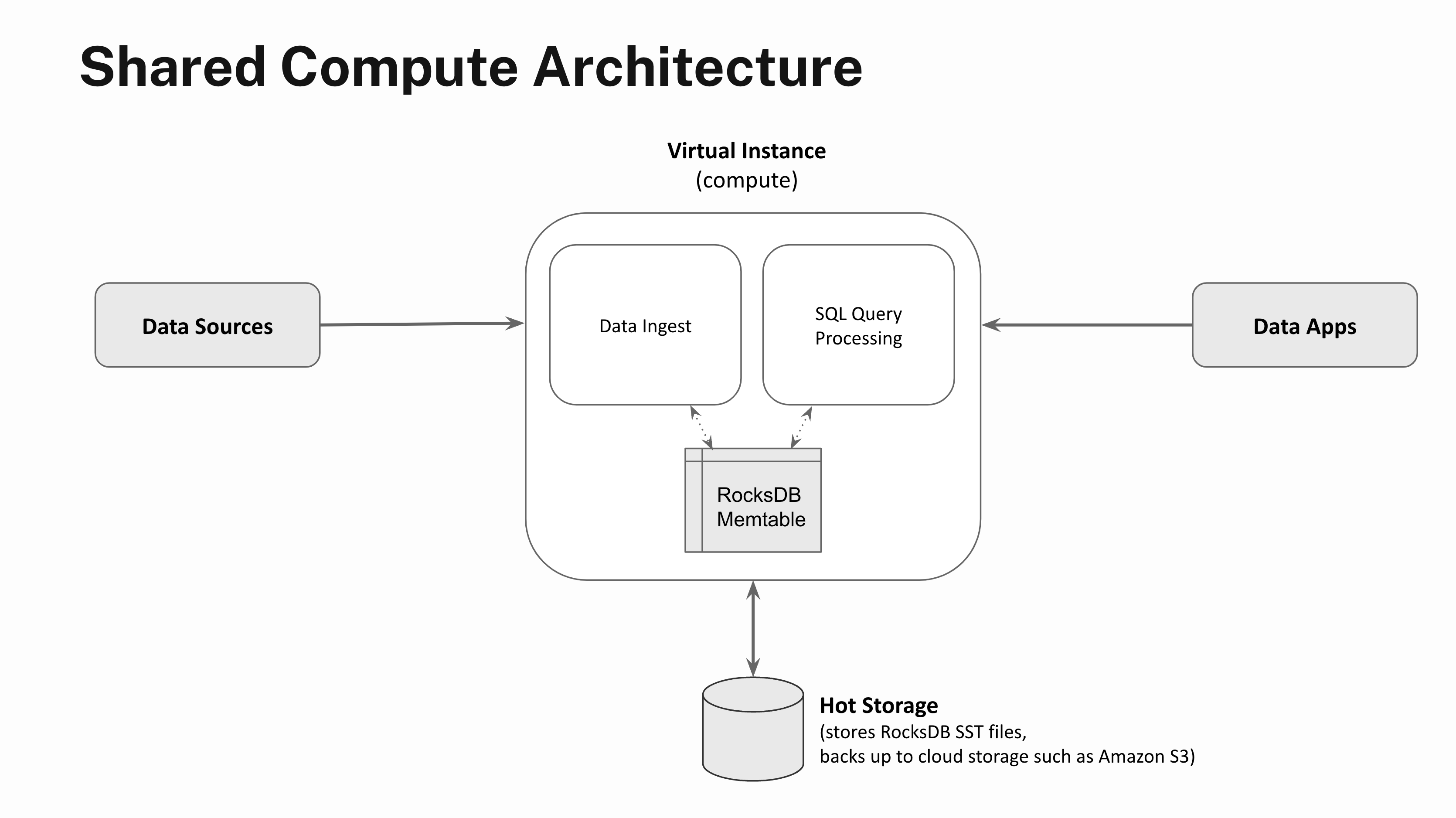
Actual-time programs call for low-latency, high-concurrency question processing. So whilst steadily backing up information to Amazon S3 supplies powerful sturdiness promises, information get admission to latencies are too sluggish to energy real-time programs. So, along with backing up the SST information to cloud garage, Rockset additionally employs an autoscaling sizzling garage tier subsidized by means of NVMe SSD garage that permits for entire separation of compute and garage.
Compute devices spun as much as carry out streaming information ingest or question processing are referred to as Digital Circumstances in Rockset. The new garage tier scales elastically according to utilization and serves the SST information to Digital Circumstances that carry out information ingestion, question processing or information compactions. The new garage tier is ready 100-200x sooner to get admission to in comparison to chilly garage similar to Amazon S3, which in flip permits Rockset to offer low-latency, high-throughput question processing.
Step 2: Separate Information Ingestion and Question Processing Code Paths
Letâs cross one degree deeper and take a look at the entire other portions of knowledge ingestion. When information will get written right into a real-time database, there are necessarily 4 duties that wish to be accomplished:
- Information parsing: Downloading information from the information supply or the community, paying the community RPC overheads, information decompressing, parsing and unmarshalling, and so forth
- Information transformation: Information validation, enrichment, formatting, sort conversions and real-time aggregations within the type of rollups
- Information indexing: Information is encoded within the databaseâs core information constructions used to retailer and index the information for quick retrieval. In Rockset, that is the place Converged Indexing is applied
- Compaction (or vacuuming): LSM engine compactors run within the background to take away stale variations of the information. Notice that this phase is not only explicit to LSM engines. Any individual who has ever run a VACUUM command in PostgreSQL will know that those operations are very important for garage engines to offer just right efficiency even if the underlying garage engine isn’t log structured.
The SQL processing layer is going throughout the conventional question parsing, question optimization and execution stages like every other SQL database.
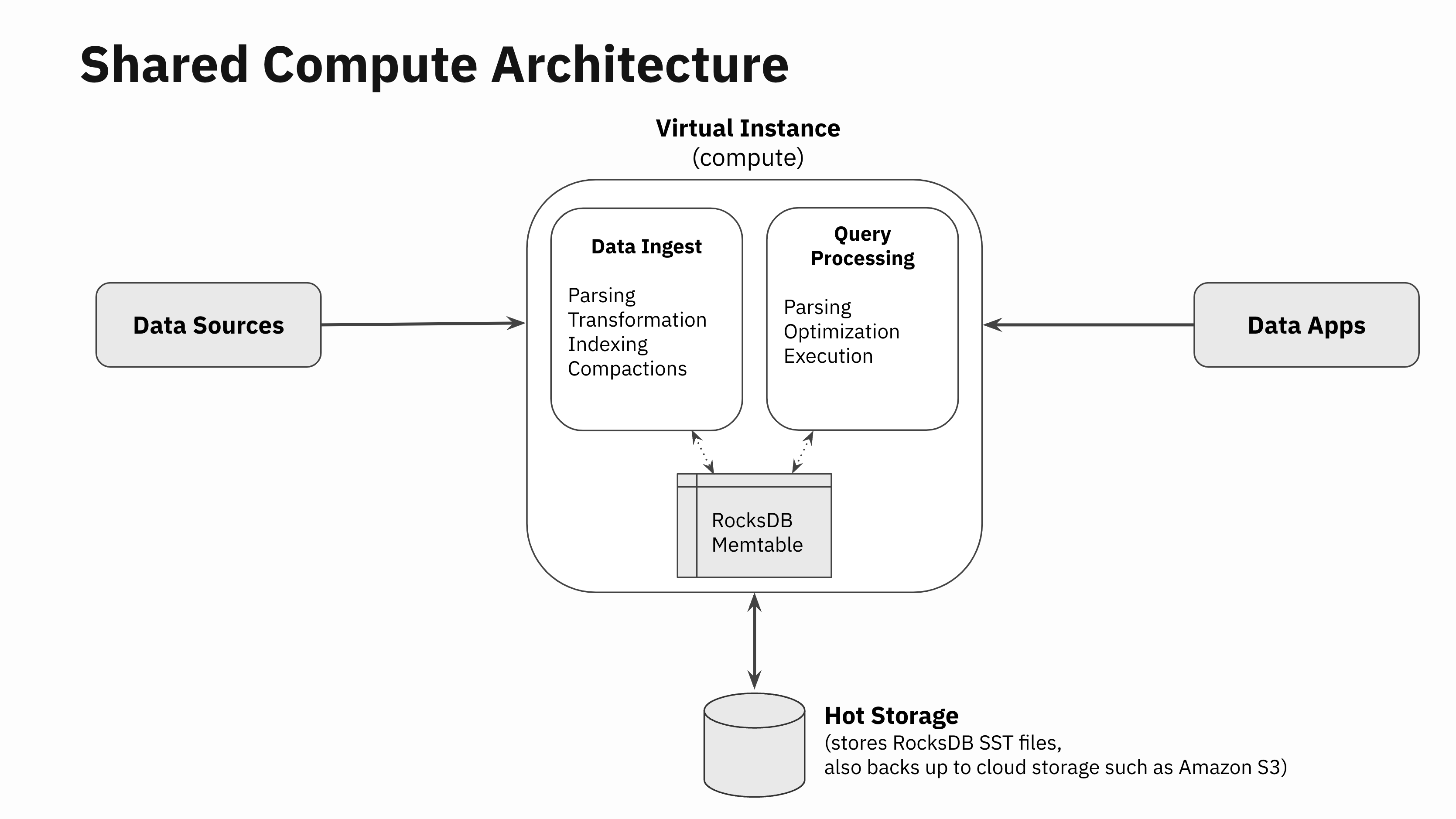
Development compute-compute separation has been a longer term purpose for us because the very starting. So, we designed Rocksetâs SQL engine to be utterly separated from the entire modules that do information ingestion. There are not any instrument artifacts similar to locks, latches, or pinned buffer blocks which might be shared between the modules that do information ingestion and those that do SQL processing out of doors of RocksDB. The information ingestion, transformation and indexing code paths paintings utterly independently from the question parsing, optimization and execution.
RocksDB helps multi-version concurrency keep an eye on, snapshots, and has an enormous frame of labor to make more than a few subcomponents multi-threaded, get rid of locks altogether and cut back lock competition. Given the character of RocksDB, sharing state in SST information between readers, writers and compactors will also be accomplished with little to no coordination. These kinds of houses permit our implementation to decouple the information ingestion from question processing code paths.
So, the one explanation why SQL question processing is scheduled at the Digital Example doing information ingestion is to get admission to the in-memory state in RocksDB memtables that cling essentially the most just lately ingested information. For question effects to mirror essentially the most just lately ingested information, get admission to to the in-memory state in RocksDB memtables is very important.
Step 3: Mirror In-Reminiscence State
Anyone within the Nineteen Seventies at Xerox took a photocopier, break up it right into a scanner and a printer, attached the ones two portions over a phone line and thereby invented the arena’s first phone fax gadget which utterly revolutionized telecommunications.
Equivalent in spirit to the Xerox hack, in probably the most Rockset hackathons a couple of 12 months in the past, two of our engineers, Nathan Bronson and Igor Canadi, took RocksDB, break up the phase that writes to RocksDB memtables from the phase that reads from the RocksDB memtable, constructed a RocksDB memtable replicator, and attached it over the community. With this capacity, you’ll be able to now write to a RocksDB example in a single Digital Example, and inside of milliseconds reflect that to a number of far off Digital Circumstances successfully.
Not one of the SST information must be replicated since the ones information are already separated from compute and are saved and served from the autoscaling sizzling garage tier. So, this replicator simplest specializes in replicating the in-memory state in RocksDB memtables. The replicator additionally coordinates flush movements in order that when the memtable is flushed at the Digital Example consuming the information, the far off Digital Circumstances know to head fetch the brand new SST information from the shared sizzling garage tier.

This easy hack of replicating RocksDB memtables is a large unencumber. The in-memory state of RocksDB memtables will also be accessed successfully in far off Digital Circumstances that don’t seem to be doing the information ingestion, thereby basically setting apart the compute wishes of knowledge ingestion and question processing.
This actual way of implementation has few very important houses:
- Low information latency: The extra information latency from when the RocksDB memtables are up to date within the ingest Digital Circumstances to when the similar adjustments are replicated to far off Digital Circumstances will also be saved to unmarried digit milliseconds. There are not any giant pricey IO prices, garage prices or compute prices concerned, and Rockset employs neatly understood information streaming protocols to stay information latencies low.
- Powerful replication mechanism: RocksDB is a competent, constant garage engine and will emit a âmemtable replication moveâ that guarantees correctness even if the streams are disconnected or interrupted for no matter explanation why. So, the integrity of the replication move will also be assured whilst concurrently preserving the information latency low. Additionally it is in reality vital that the replication is occurring on the RocksDB key-value degree in spite of everything the foremost compute heavy ingestion paintings has already came about, which brings me to my subsequent level.
- Low redundant compute expense: Little or no further compute is needed to duplicate the in-memory state in comparison to the overall quantity of compute required for the unique information ingestion. The best way the information ingestion trail is structured, the RocksDB memtable replication occurs in spite of everything the compute in depth portions of the information ingestion are entire together with information parsing, information transformation and information indexing. Information compactions are simplest carried out as soon as within the Digital Example this is consuming the information, and the entire far off Digital Circumstances will merely select the brand new compacted SST information immediately from the new garage tier.
It must be famous that there are different naive techniques to split ingestion and queries. A technique could be by means of replicating the incoming logical information move to 2 compute nodes, inflicting redundant computations and doubling the compute wanted for streaming information ingestion, transformations and indexing. There are lots of databases that declare equivalent compute-compute separation features by means of doing âlogical CDC-like replicationâ at a excessive degree. You must be doubtful of databases that make such claims. Whilst duplicating logical streams might appear âjust right sufficientâ in trivial instances, it comes at a prohibitively pricey compute value for large-scale use instances.
Leveraging Compute-Compute Separation
There are a lot of real-world eventualities the place compute-compute separation will also be leveraged to construct scalable, environment friendly and powerful real-time programs: ingest and question compute isolation, more than one programs on shared real-time information, limitless concurrency scaling and dev/check environments.
Ingest and Question Compute Isolation
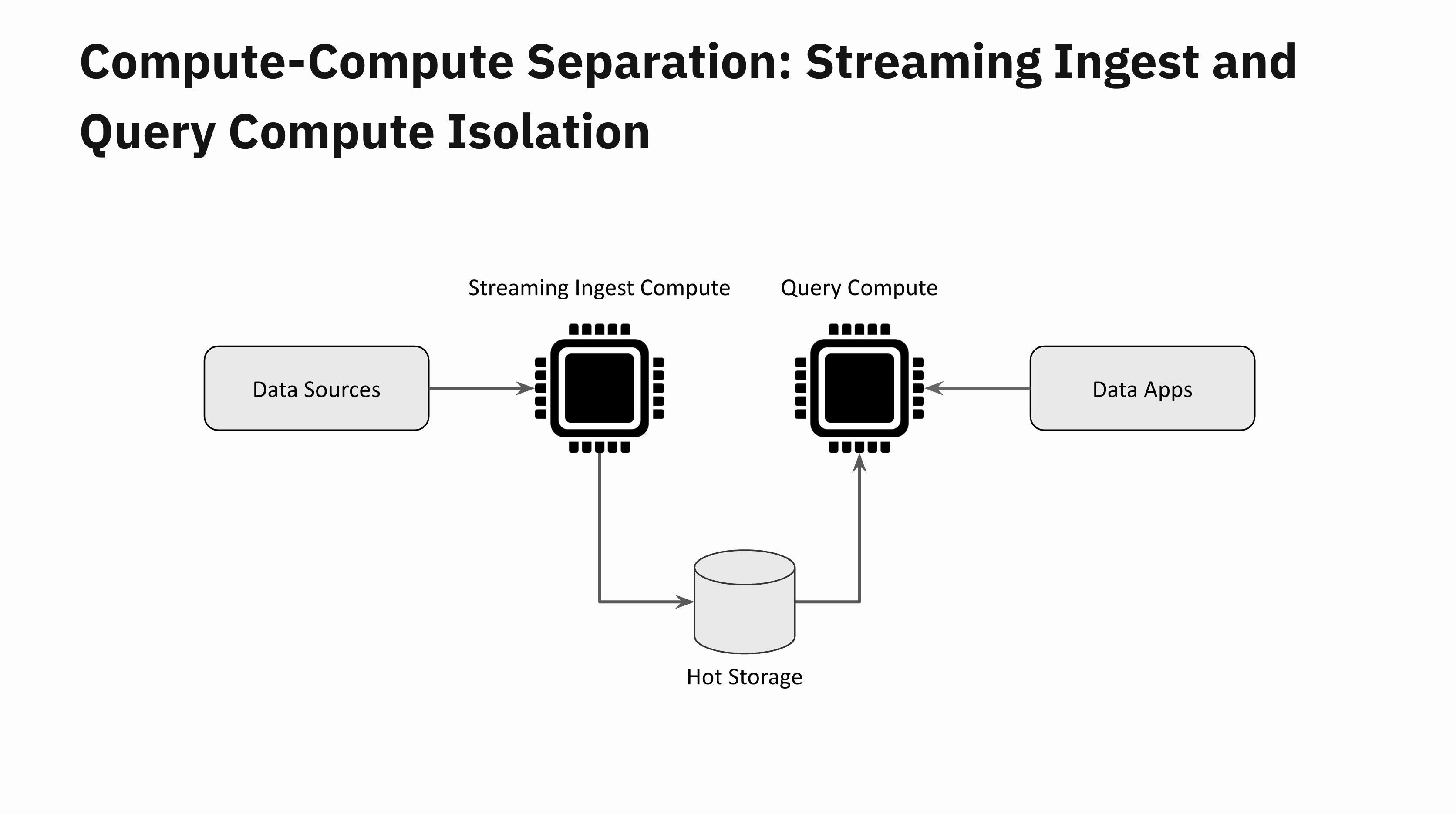
Imagine a real-time utility that receives a surprising flash flood of latest information. This must be somewhat simple to maintain with compute-compute separation. One Digital Example is devoted to information ingestion and a far off Digital Example one for question processing. Those two Digital Circumstances are totally remoted from each and every different. You’ll be able to scale up the Digital Example devoted to ingestion if you wish to stay the information latencies low, however without reference to your information latencies, your utility queries will stay unaffected by means of the information flash flood.
More than one Programs on Shared Actual-Time Information

Consider construction two other programs with very other question load traits at the similar real-time information. One utility sends a small selection of heavy analytical queries that arenât time delicate and the opposite utility is latency delicate and has very excessive QPS. With compute-compute separation you’ll be able to totally isolate more than one utility workloads by means of spinning up one Digital Example for the primary utility and a separate Digital Example for the second one utility.
Limitless Concurrency Scaling
Limitless Concurrency Scaling
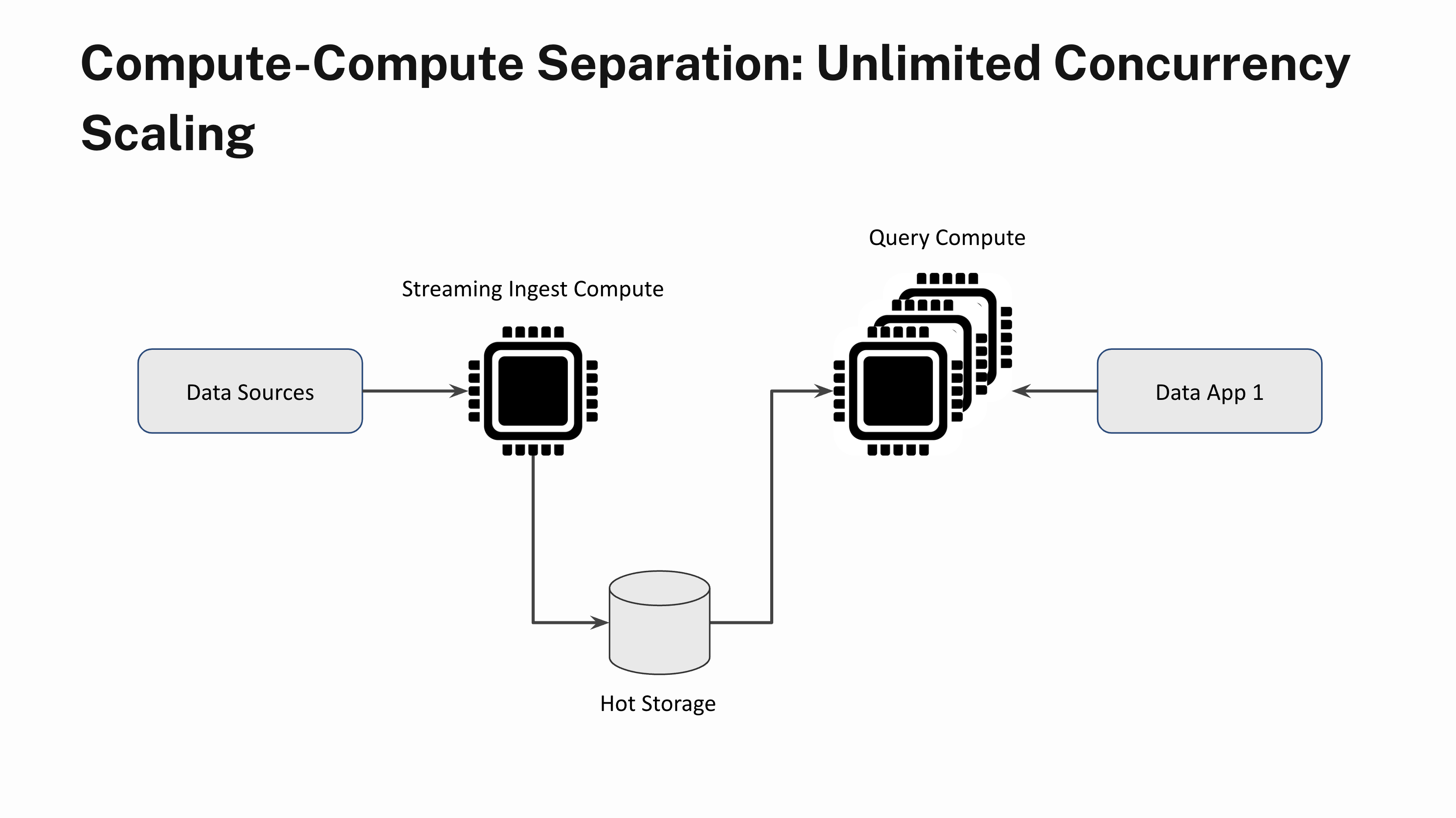
Say you’ve gotten a real-time utility that sustains a gradual state of 100 queries consistent with 2d. Sometimes, when numerous customers login to the app on the similar time, you spot question bursts. With out compute-compute separation, question bursts will lead to a deficient utility efficiency for all customers right through sessions of excessive call for. With compute-compute separation, you’ll be able to immediately upload extra Digital Circumstances and scale out linearly to maintain the higher call for. You’ll be able to additionally scale the Digital Circumstances down when the question load subsides. And sure, you’ll be able to scale out with no need to fret about information lags or stale question effects.
Advert-hoc Analytics and Dev/Check/Prod Separation
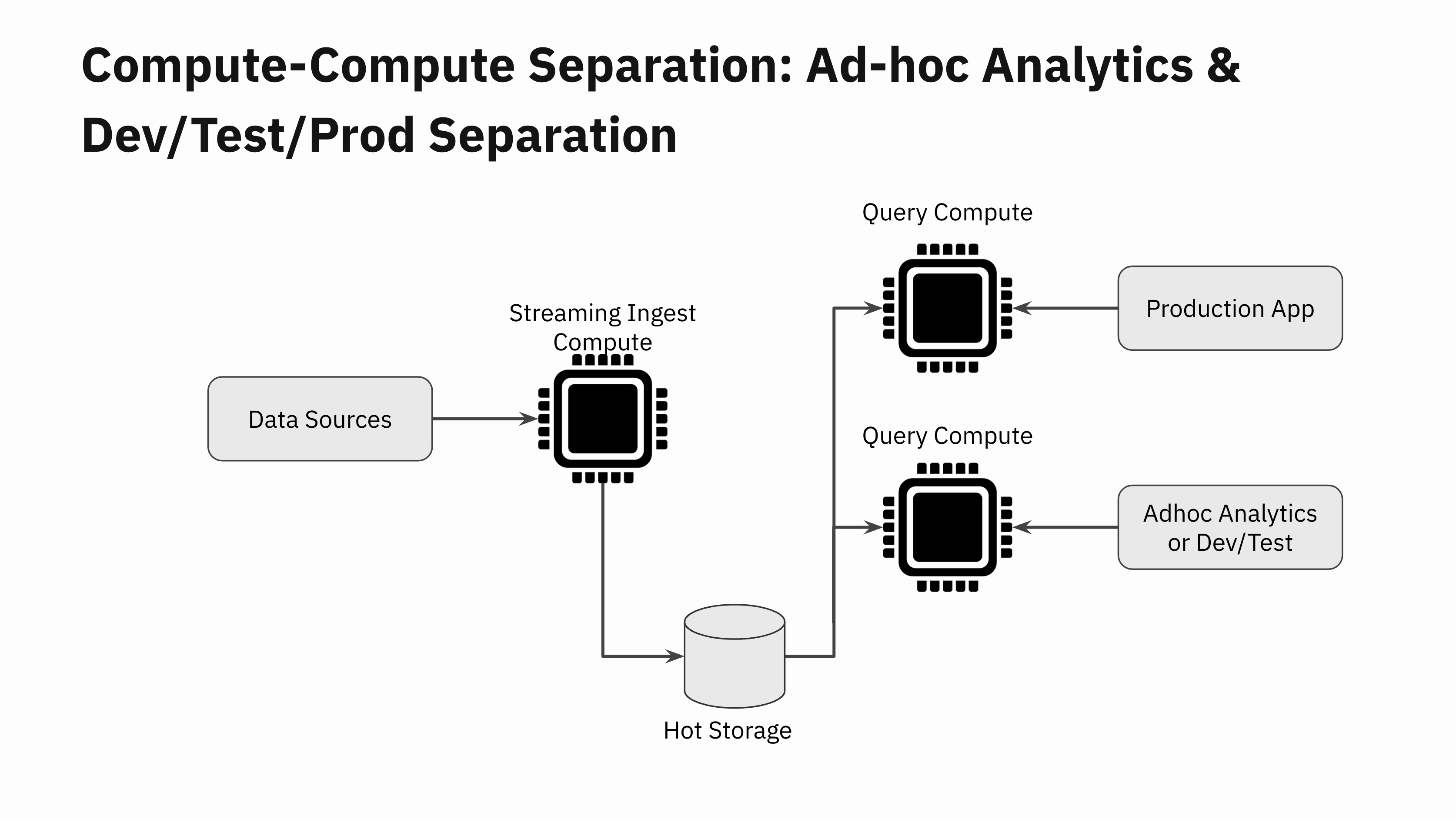
The following time you carry out ad-hoc analytics for reporting or troubleshooting functions for your manufacturing information, you’ll be able to accomplish that with out being worried concerning the damaging have an effect on of the queries for your manufacturing utility.
Many dev/staging environments can not have the funds for to make a complete replica of the manufacturing datasets. In order that they finally end up doing trying out on a smaller portion in their manufacturing information. This may reason surprising efficiency regressions when new utility variations are deployed to manufacturing. With compute-compute separation, you’ll be able to now spin up a brand new Digital Example and do a snappy efficiency check of the brand new utility edition sooner than rolling it out to manufacturing.
The probabilities are never-ending for compute-compute separation within the cloud.
Long term Implications for Actual-Time Analytics
Ranging from the hackathon mission a 12 months in the past, it took a super workforce of engineers led by means of Tudor Bosman, Igor Canadi, Karen Li and Wei Li to show the hackathon mission right into a manufacturing grade gadget. I’m extraordinarily proud to unveil the potential of compute-compute separation as of late to everybody.
That is an absolute recreation changer. The consequences for the way forward for real-time analytics are large. Any individual can now construct real-time programs and leverage the cloud to get large potency and reliability wins. Development large scale real-time programs don’t wish to incur exorbitant infrastructure prices because of useful resource overprovisioning. Programs can dynamically and briefly adapt to converting workloads within the cloud, with the underlying database being operationally trivial to control.
On this liberate weblog, I’ve simply scratched the skin at the new cloud structure for compute-compute separation. Iâm excited to delve additional into the technical main points in a communicate on March fifteenth at 9am PST/ 12pm EST with Nathan Bronson, probably the most brains at the back of the memtable replication hack and core contributor to Tao and F14 at Meta. Come sign up for us for the tech communicate and glance underneath the hood of the brand new structure and get your questions responded!